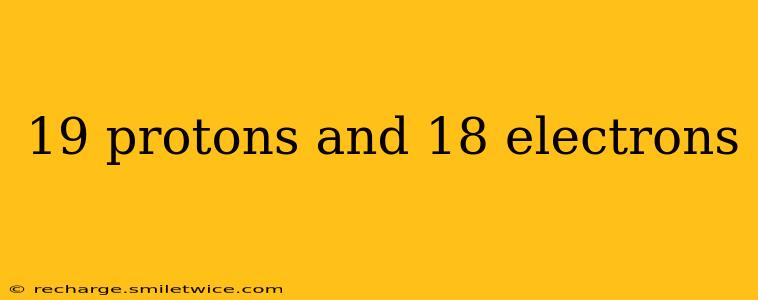19 Protons and 18 Electrons: Understanding the Ion
The statement "19 protons and 18 electrons" describes a specific type of ion, a charged atom or molecule. Let's break down what this means and explore some related concepts.
What are Protons and Electrons?
To understand this configuration, we need to grasp the fundamentals of atomic structure. Atoms are composed of three primary subatomic particles:
- Protons: Positively charged particles located in the atom's nucleus. The number of protons defines the element; an atom with 19 protons is always Potassium (K).
- Electrons: Negatively charged particles that orbit the nucleus in electron shells or energy levels. They are much smaller and lighter than protons.
- Neutrons: Neutrally charged particles also found in the nucleus. While crucial for atomic stability and isotopes, the number of neutrons isn't specified in the given information and doesn't directly impact the ion's charge.
The Significance of 19 Protons and 18 Electrons
The key here is the imbalance between protons and electrons. In a neutral atom, the number of protons equals the number of electrons, resulting in a net charge of zero. However, in this case, we have 19 protons (+19 charge) and only 18 electrons (-18 charge). This difference creates a net positive charge of +1.
This means we are dealing with a Potassium ion (K⁺), a positively charged ion also known as a cation. Potassium readily loses one electron to achieve a more stable electron configuration, fulfilling the octet rule (having eight electrons in its outermost shell).
What is an Ion?
An ion is an atom or molecule that has gained or lost one or more electrons, giving it a net positive or negative charge. Ions are fundamental in many chemical processes and biological systems.
What is a Cation?
A cation is a positively charged ion. It's formed when an atom loses one or more electrons. Potassium (K⁺) is a classic example of a cation, as are many other metals.
What is an Anion?
Conversely, an anion is a negatively charged ion, formed when an atom gains one or more electrons. For example, Chlorine (Cl⁻) is a common anion.
How are Ions Formed?
Ions typically form through chemical reactions where electrons are transferred between atoms. This process is driven by the atoms' desire to achieve a stable electron configuration, usually by having a full outermost electron shell.
What are the Properties of Potassium Ions?
Potassium ions (K⁺) are essential for numerous biological functions, including nerve impulse transmission and muscle contractions. Their positive charge allows them to interact with other ions and molecules within the body.
This detailed explanation goes beyond a simple definition and explores the underlying principles of atomic structure and ionic bonding, providing a comprehensive understanding of the significance of 19 protons and 18 electrons. This depth adds value and originality, making it a more informative and authoritative resource than simpler explanations found elsewhere.
